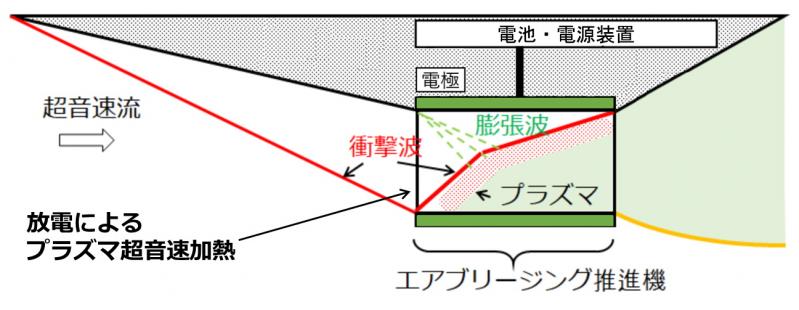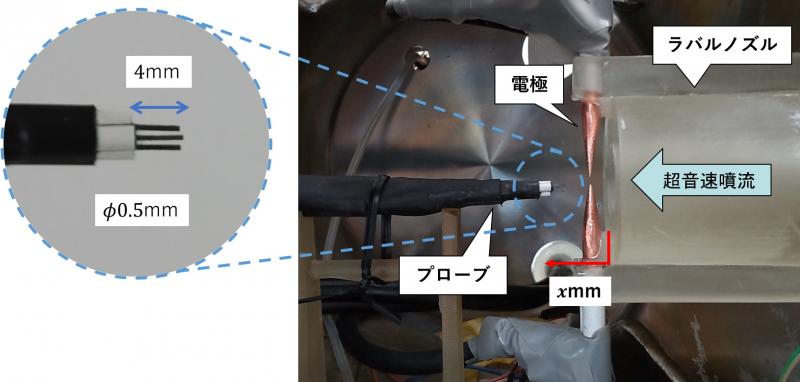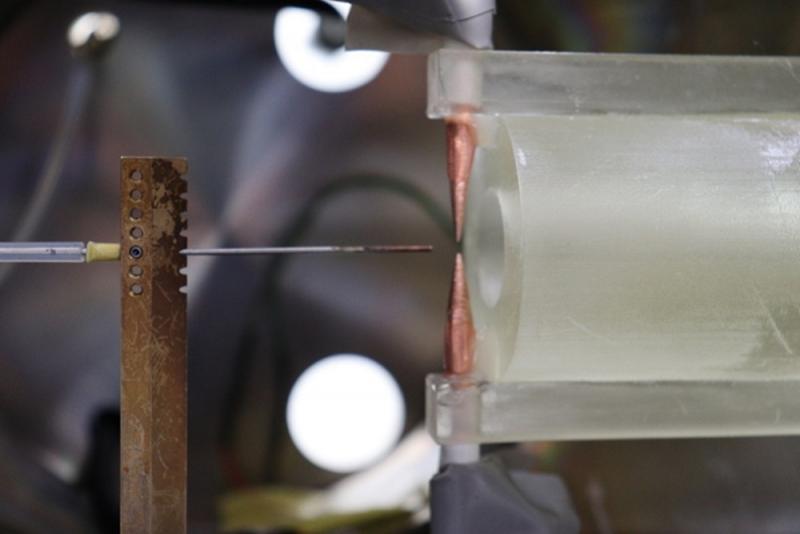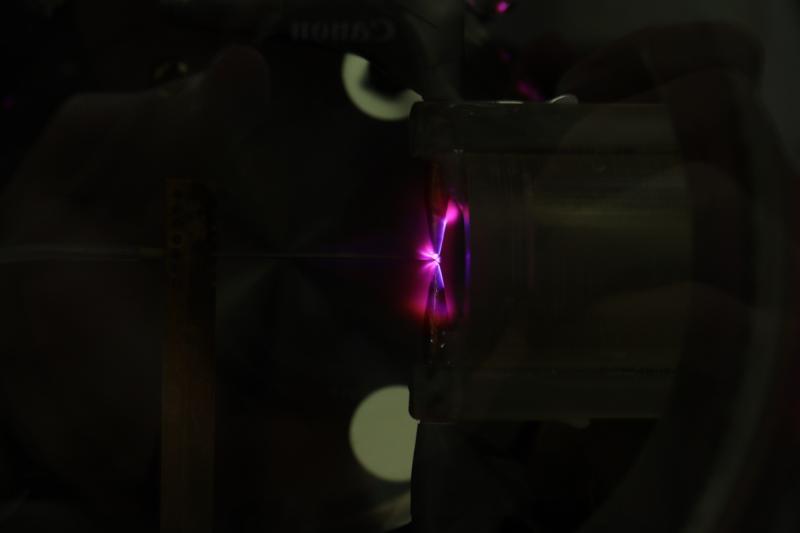大気吸込式プラズマジェット推進
(Air-breathing Plasma Jet Propulsion)
1. 研究背景 (Background of Research)
近年,環境問題への意識の高まりから,航空機の電動化に注目が集まっています.従来の燃焼機関(レシプロエンジンやジェットエンジン)を電動化することで,地球温暖化の原因となる二酸化炭素だけでなく,排出ガスに含まれる有害物質も低減できると期待されており,JAXAは2020年代に小出力用途を対象とした電動化技術の社会実装を開始するといった目標を設定しています[1].
しかし,現在提案されている電動航空機は,モータで回転翼を駆動するといった推進方式が前提であり,従来の推進機と同様に空気力学的な制約で飛行性能が制限されてしまいます.今後,電動航空機にによる高速飛行や高高度飛行への要求が高まることは明白であり,既存の燃焼機関を置き換えるだけの解決策では技術的革新が望めないと考えています.
そこで,電動航空機に対する新たな基礎研究の取り組みとして「大気吸い込み式プラズマ推進」の実現可能性について検討しています.これは,成層圏以上の大気を用いてプラズマを発生させ,これを推進力の発生に利用するといったものです(Fig1).プラズマ生成による大気へのエンタルピー付与と電磁力を介した運動量発生は,従来の燃焼機関に立ちはだかった化学反応や空気力学の制約を受けないと予想されるため,電動航空機の実現や性能向上に寄与すると期待しています.
In recent years, increasing awareness of environmental issues has drawn attention to the electrification of aircraft. The electrification of conventional combustion engines (reciprocating engines and jet engines) is expected to reduce not only carbon dioxide, which causes global warming, but also toxic substances contained in exhaust gases. The goal has been set [1].
However, currently proposed electric aircraft are based on a propulsion system in which the rotor blades are driven by a motor, and flight performance is limited by aerodynamic constraints similar to those of conventional propulsion aircraft. It is clear that the demand for high-speed and high-altitude flight by electric aircraft will increase in the future, and we believe that technological innovation cannot be achieved by simply replacing existing combustion engines.
Therefore, we are studying the feasibility of "Air-breathing Plasma Jet Propulsion" as a new basic research approach for electric aircraft. This is done by using the atmosphere above the stratosphere to generate plasma, which is then used to generate propulsion (Fig.1). The enthalpy imparted to the atmosphere by plasma generation and the generation of momentum via electromagnetic forces are expected to be free from the constraints of chemical reactions and aerodynamics that have hindered conventional combustion engines, and are expected to contribute to the realization and performance improvement of electric aircraft.
 Fig.1 大気吸い込み式プラズマジェットエンジン (Air-breathing Plasma Jet Propulsion)
Fig.1 大気吸い込み式プラズマジェットエンジン (Air-breathing Plasma Jet Propulsion)
2. 研究目的
(Purpose of the Research)
大気吸い込み式プラズマ推進を実用化する場合,流れの変化や得られる推力のシミュレーションを行う必要があります.そこで本研究室では,実験による各種計測を行うことで,超音速プラズマの解析手法を確立することを長期的な目的と設定しています.
また,長期的目的を達成するにあたって,以下に示した短期的な目的を設定し各自の研究を行っています.
- 圧力分布を測定することにより,プラズマが流れに及ぼす影響,および流れのエネルギー変化を解明する
- プラズマパラメタを測定することにより,超音速プラズマの電気的性質,および流れのエネルギー変化を解明する
- 観測されるプラズマの形状と各種計測結果から,超音速プラズマの構造を解明する
The practical application of air-breathing plasma jet propulsion requires simulation of the flow variation and the thrust obtained. Therefore, the long-term objective of this laboratory is to establish an analysis method for supersonic plasmas by conducting various experimental measurements.
In order to achieve the long-term objectives, the following short-term objectives are also set for each student's research.
- Elucidate the effect of the plasma on the flow and the energy change of the flow by measuring the pressure distribution
- Elucidate the electrical properties of supersonic plasma and the flow energy change by measuring plasma parameters
- Elucidate the structure of supersonic plasma from the observed plasma shape and various measurements
3.研究内容 (Research)
本研究室では,真空ポンプとラバルノズルを用いて超音速流をつくり,電極から放電を行うことで,超音速プラズマを再現しています.(実験装置の詳細に関してはFacilitiesをご覧ください.)実験装置により作り出したプラズマ中の各種物理量をセンサで測定することで,超音速プラズマの特性解明を目指しています.
また,こうした超音速流プラズマの測定は大気吸い込み式プラズマ推進の実用化に寄与するだけでなく,測定・解析の過程でプラズマによる高速流制御や宇宙プラズマに対する知見も与えてくれると考えられます.
In our laboratory, supersonic plasma is reproduced by creating a supersonic flow using a vacuum pump and a laval nozzle, and discharging from an electrode. (For details of the experimental apparatus, please see Facilities.) We aim to elucidate the characteristics of supersonic plasma by measuring various physical quantities in the plasma produced by the experimental apparatus using sensors.
The measurement of such supersonic flow plasmas will not only contribute to the practical application of air-breathing plasma jet propulsion, but will also provide insight into high-speed flow control by plasma and space plasma in the process of measurement and analysis.
3.1 静電プローブによる超音速プラズマ中のプラズマパラメタの測定
(Measurement of plasma parameters in supersonic plasma by electrostatic probe)
プラズマの電気的性質を解析するために,静電プローブを用いた計測を行っています(Fig.2)[2].静電プローブ法では,電子密度や電子温度といったプラズマパラメタを測定,算出することができ,得られたプラズマパラメタを解析することにより,プラズマの状態(密度や形態)を解明することが可能です.噴流速度や圧力条件を変えて測定を行い,プラズマによって流れに与えられる影響やエネルギーを調査します.Fig.2に示したのは,解析が簡単で即応性のあるトリプルプローブ法と呼ばれるものですが,これは数あるプローブ測定法の一つなので,今後は他のプローブ測定法も実施していく予定です.
To analyze the electrical properties of plasmas, we use electrostatic probe measurements (Fig. 2). The electrostatic probe method can measure and calculate plasma parameters such as electron density and electron temperature, and the obtained plasma parameters can be analyzed to elucidate the plasma state (density, morphology, etc.). The triple-probe method shown in Fig. 2 is one of many probing methods that can be easily and quickly analyzed, so other probing methods will be developed in the future. We plan to implement it.
 Fig.2 静電プローブによるプラズマパラメタの測定(Measuring plasma parameters with electrostatic probes)
Fig.2 静電プローブによるプラズマパラメタの測定(Measuring plasma parameters with electrostatic probes)
3.2 ピトー管を用いた超音速流中のプラズマによる圧力変化の測定
(Measurement of pressure change due to plasma in supersonic flow using pitot tube)
プラズマの生成が流れに対してどのような影響を与えるかを調べるため,ピトー管を用いた圧力計測を行っています(Fig.3).
ピトー管の位置は動かすことができ,少しずつずらしながら測定を行うことで,圧力分布を解析することができます.
また,Fig.4に示したようにプラズマの概観は目視で確認できるため,圧力分布との比較により,流れの構造に対するプラズマの影響を評価できると期待されています.
To investigate the effect of plasma generation on the flow, pressure measurements are made using a pitot tube (Fig. 3).
The position of the pitot tube can be moved, and the pressure distribution can be analyzed by shifting it little by little.
As shown in Fig. 4, an overview of the plasma can be visually confirmed, and comparison with the pressure distribution is expected to allow evaluation of the effect of the plasma on the flow structure.
 Fig.3 ピトー管による圧力測定 (Pressure measurement with pitot tube)
Fig.3 ピトー管による圧力測定 (Pressure measurement with pitot tube)
 Fig.4 放電プラズマ (Discharge Plasma)
Fig.4 放電プラズマ (Discharge Plasma)
参考文献 (Reference)
[1]:航空機電動化 将来ビジョン ver.1,宇宙航空研究開発機構,2018,航空機電動化(ECLAIR)コンソーシアム,https://www.aero.jaxa.jp/about/hub/eclair/pdf/eclair_vision.pdf
[2]:雨宮 宏,和田 元,豊田 浩孝,中村 圭二,安藤 晃,上原 和也,小山孝一郎,酒井 道,橘 邦英,プローブ計測の基礎から応用まで,2005,プラズマ核融合学会誌81号7巻,482-525項,http://www.jspf.or.jp/Journal/PDF_JSPF/jspf2005_07/jspf2005_07-482.pdf